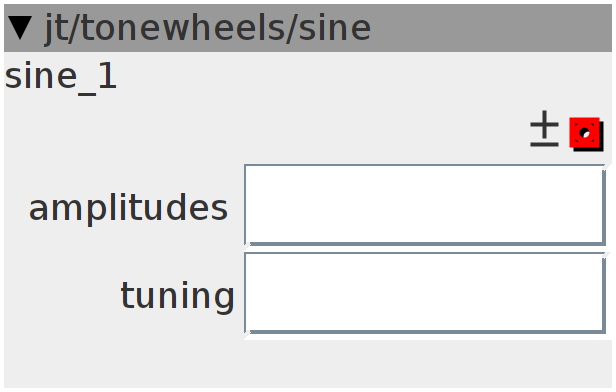sine
Sine wave tonewheels. Processes note number 24 to 117. No amplitude interpolation.
Inlets
None
Outlets
frac32buffer.bipolar sine wave
Attributes
objref Table containing the amplitudes (32bit)
objref Tuning table
Declaration
class osc_sine_plus_octave_cheap {
// processes TWO octaves!
// cheaper version, but fails when cos(f)<0.5 or sin(f)>0.5
public:
void init() {}
void render(int32_t *pOut, int32_t amp1, int32_t amp2, uint32_t freq,
uint32_t phase) {
// out: pointer to s32 output buffer, adds values
// amp: s32 amplitude
int i;
amp1 = amp1 >> 3;
int32_t ss = sin_q31(phase);
int32_t sc = sin_q31(phase + 0x40000000);
ss = ss >> 1;
sc = sc >> 1;
int32_t rs = sin_q31(freq);
int32_t rc = sin_q31(freq + 0x40000000);
rs = rs << 1;
rc = (0x80000000 - rc) << 1;
for (i = 0; i < BUFSIZE; i++) {
int32_t ss2 = __SMMLA(sc, rs, ___SMMLS(ss, rc, ss));
sc = ___SMMLS(ss, rs, ___SMMLS(sc, rc, sc));
ss = ss2;
int32_t out = *pOut;
out = __SMMLA(ss, amp1, out);
int32_t ss2f = ___SMMUL(sc, ss);
out = __SMMLA(ss2f, amp2, out);
*pOut = out;
pOut++;
}
}
};
class osc_sine_plus_octave {
// processes TWO octaves!
// slightly more expensive version works for all frequencies
public:
void init() {}
void render(int32_t *pOut, int32_t amp1, int32_t amp2, uint32_t freq,
uint32_t phase) {
// out: pointer to s32 output buffer, adds values
// amp: s32 amplitude
int i;
amp1 = amp1 >> 3;
int32_t ss = sin_q31(phase);
int32_t sc = sin_q31(phase + 0x40000000);
ss = ss >> 1;
sc = sc >> 1;
int32_t rs = sin_q31(freq);
int32_t rc = sin_q31(freq + 0x40000000);
for (i = 0; i < BUFSIZE; i++) {
int32_t ss2 = __SMMLA(ss, rc, ___SMMUL(sc, rs)) << 1;
sc = ___SMMLS(ss, rs, ___SMMUL(sc, rc)) << 1;
ss = ss2;
int32_t out = *pOut;
out = __SMMLA(ss, amp1, out);
int32_t ss2f = ___SMMUL(sc, ss);
out = __SMMLA(ss2f, amp2, out);
*pOut++ = out;
}
}
};
static const int n_octaves3 = 6;
static const int n_octaves4 = 2;
class chroma {
int phase;
public:
osc_sine_plus_octave_cheap octaves3[n_octaves3 / 2];
osc_sine_plus_octave octaves4[n_octaves4 / 2];
void init() {
phase = 0;
int i;
for (i = 0; i < n_octaves3 / 2; i++) {
octaves3[i].init();
}
for (i = 0; i < n_octaves4 / 2; i++) {
octaves4[i].init();
}
};
void render(uint32_t freq, int32_t *pOut, int32_t *amp) {
amp += 24;
phase += freq << 4;
uint32_t p = phase;
uint32_t f = freq;
int i;
for (i = 0; i < n_octaves3 / 2; i++) {
octaves3[i].render(pOut, *amp, amp[12], f, p);
amp += 24;
p = p << 2;
f = f << 2;
}
for (i = 0; i < n_octaves4 / 2; i++) {
octaves4[i].render(pOut, *amp, amp[12], f, p);
amp += 24;
p = p << 2;
f = f << 2;
}
}
};
chroma chromas[12];
Init
int i;
for (i = 0; i < 12; i++) {
chromas[i].init();
}
Control Rate
int i;
for (i = 0; i < BUFSIZE; i++) {
outlet_wave[i] = 0;
}
for (i = 0; i < 12; i++) {
chromas[i].render(attr_tuning.array[i] >> 3, &outlet_wave[0],
&attr_amplitudes.array[i]);
}